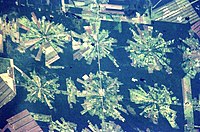
Photo from wikipedia
Abstract Fires, among other forms of natural and anthropogenic disturbance, play a central role in regulating the location, composition and biomass of forests. Understanding the role of fire in global… Click to show full abstract
Abstract Fires, among other forms of natural and anthropogenic disturbance, play a central role in regulating the location, composition and biomass of forests. Understanding the role of fire in global forest loss is crucial in constraining land‐use change emissions and the global carbon cycle. We analysed the relationship between forest loss and fire at 500 m resolution based on satellite‐derived data for the 2003–2018 period. Satellite fire data included burned area and active fire detections, to best account for large and small fires, respectively. We found that, on average, 38 ± 9% (± range) of global forest loss was associated with fire, and this fraction remained relatively stable throughout the study period. However, the fraction of fire‐related forest loss varied substantially on a regional basis, and showed statistically significant trends in key tropical forest areas. Decreases in the fraction of fire‐related forest loss were found where deforestation peaked early in our study period, including the Amazon and Indonesia while increases were found for tropical forests in Africa. The inclusion of active fire detections accounted for 41%, on average, of the total fire‐related forest loss, with larger contributions in small clearings in interior tropical forests and human‐dominated landscapes. Comparison to higher‐resolution fire data with resolutions of 375 and 20 m indicated that commission errors due to coarse resolution fire data largely balanced out omission errors due to missed small fire detections for regional to continental‐scale estimates of fire‐related forest loss. Besides an improved understanding of forest dynamics, these findings may help to refine and separate fire‐related and non‐fire‐related land‐use change emissions in forested ecosystems.
Journal Title: Global Change Biology
Year Published: 2021
Link to full text (if available)
Share on Social Media: Sign Up to like & get
recommendations!